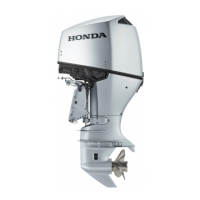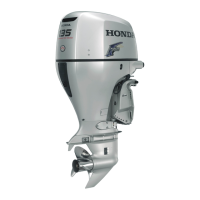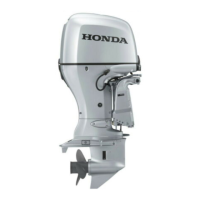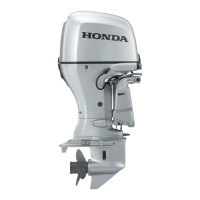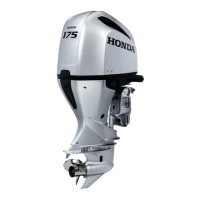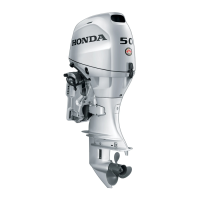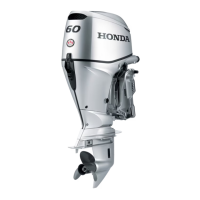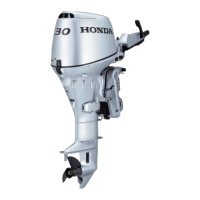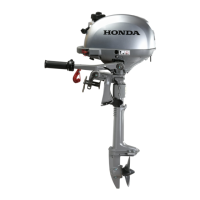Do you have a question about the HONDA marine BF115D and is the answer not in the manual?
General safety guidelines, operator responsibilities, and specific hazards like burns and carbon monoxide poisoning.
Details the locations and purpose of safety labels on the outboard motor.
Identifies major external parts like engine cover, stern bracket, propeller, and various ports.
Illustrates and names parts of the remote control box and switch panels.
Identifies optional equipment like tachometers, trim meters, and trolling control switches.
Explains the function and operation of remote control levers for R1, R2, and R3 types.
Details the operation of ignition switches, neutral release levers, and fast idle controls.
Explains the function and meaning of various warning lights and buzzers for engine status.
Describes operation of trim/tilt switches, TRL control, and manual relief valve adjustments.
Explains emergency stop systems, tilt lock levers, trim tabs, and anodes.
Identifies cooling system access points, latches, and optional gauges like tachometers.
Guides on selecting the correct transom height and installing the motor on the boat's centerline.
Details the correct installation height relative to the anticavitation plate and general mounting procedures.
Explains how to inspect outboard motor angle for performance and proper battery connection procedures.
Guides on installing remote control boxes, cables, and determining correct cable length.
Provides guidance on selecting the correct propeller and connecting the fuel line.
Details engine cover removal/installation and procedures for checking and refilling engine oil.
Explains fuel requirements, handling precautions, and guidelines for gasoline containing alcohol.
Outlines checks for propeller, lever friction, water separator, and battery.
Covers checks for fuel hoses, switches, stern bracket, tool kit, and anodes.
Guides on priming the fuel system and the step-by-step procedure for starting the engine.
Explains how to check cooling water flow and oil pressure indicator after starting the engine.
Provides a detailed procedure for breaking in a new outboard motor over the first 10 hours.
Explains the process of shifting gears into forward, neutral, and reverse for different control types.
Guides on cruising techniques, adjusting trim angle for optimal performance, and tilting the motor.
Explains the trolling control switch, manual relief valve, and trim tab adjustment procedures.
Details the engine protection systems, warning indicators, and buzzer functions for various faults.
Explains the over-rev limiter, anode function, and procedures for shallow water operation.
Provides guidance on operating boats equipped with multiple outboard motors simultaneously.
Details the procedures for both emergency engine stops and normal shutdown processes.
Guides on disconnecting the fuel line before transport and general procedures for transporting the motor.
Provides important precautions and recommendations for trailering a boat with the outboard motor attached.
Details the steps for thoroughly cleaning and flushing the outboard motor with fresh water after use.
Lists the tools and owner's manual supplied with the outboard motor for maintenance.
Outlines the recommended periodic maintenance schedule based on time or operating hours.
Provides detailed instructions for changing engine oil, including capacity and recommended types.
Explains how to inspect, replace, and gap spark plugs for optimal engine operation.
Illustrates and describes the various points requiring lubrication with grease or oil.
Guides on inspecting and replacing the fuel filter to ensure proper fuel delivery.
Details the procedure for cleaning the water separator to prevent water accumulation in the fuel system.
Explains the importance of emission control and identifies symptoms that may affect motor emissions.
Covers battery handling, inspection, fluid level checks, cleaning, and terminal maintenance.
Explains how to identify and replace blown fuses, including main and ACG fuses.
Provides instructions for safely removing and installing the outboard motor propeller.
Details the necessary steps for servicing an outboard motor that has been submerged in water.
Guides on proper fuel handling and draining the fuel tank and vapor separator for storage.
Explains the procedure for changing engine oil and preparing cylinders for long-term storage.
Provides instructions for safely storing the battery to maintain its charge and condition.
Details the correct vertical or horizontal positions for storing the outboard motor.
Advises on the proper and environmentally compliant disposal of the product, battery, and engine oil.
Provides a guide to diagnosing and resolving issues indicated by warning systems and indicators.
Lists the technical specifications for BF115D, BF135A, and BF150A models.
Presents measured noise and vibration levels for the outboard motors according to standards.
Lists contact details for major Honda distributors across various European countries.
Outlines the content and structure of the EC Declaration of Conformity for the product.
| Engine Type | 4-Stroke |
|---|---|
| Max Output | 115 HP |
| Starting System | Electric |
| Cooling System | Water Cooled |
| Cylinders | 4 |
| Full Throttle RPM Range | 5, 000 - 6, 000 RPM |
| Fuel Delivery | Electronic Fuel Injection |
| Exhaust | Through Propeller |
| Lubrication | Wet Sump |
| Trim Range | -4° to +16° |
| Steering | Remote |
| Displacement | 1496 cc (91.3 cubic inches) |
| Fuel System | PGM-FI (Programmed Fuel Injection) |
| Bore & Stroke | 73mm x 89.2mm |
| Rated Power | 115 HP |
| Propeller Rotation | Standard |
| Shaft Length | 20 in / 25 in |
